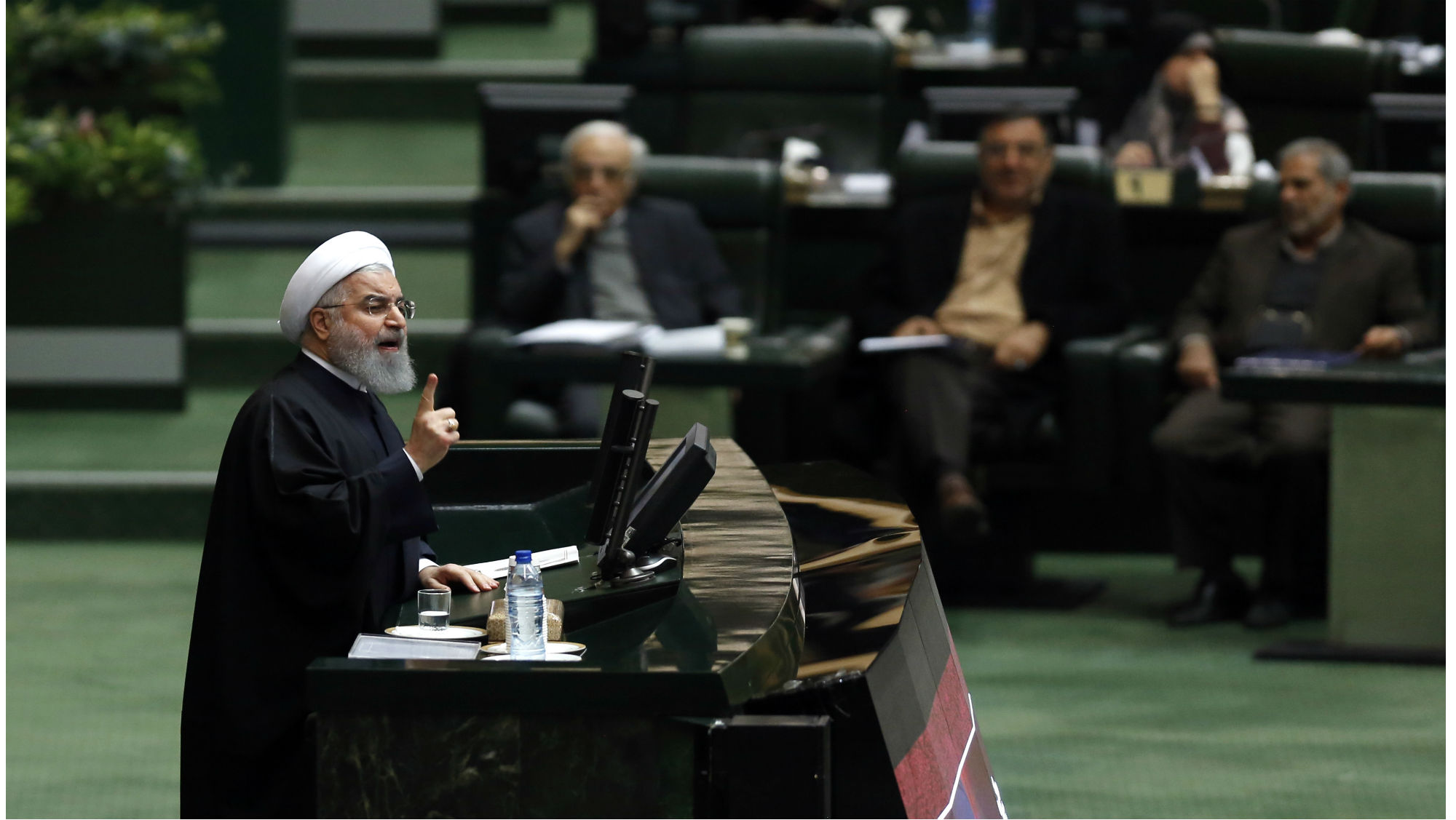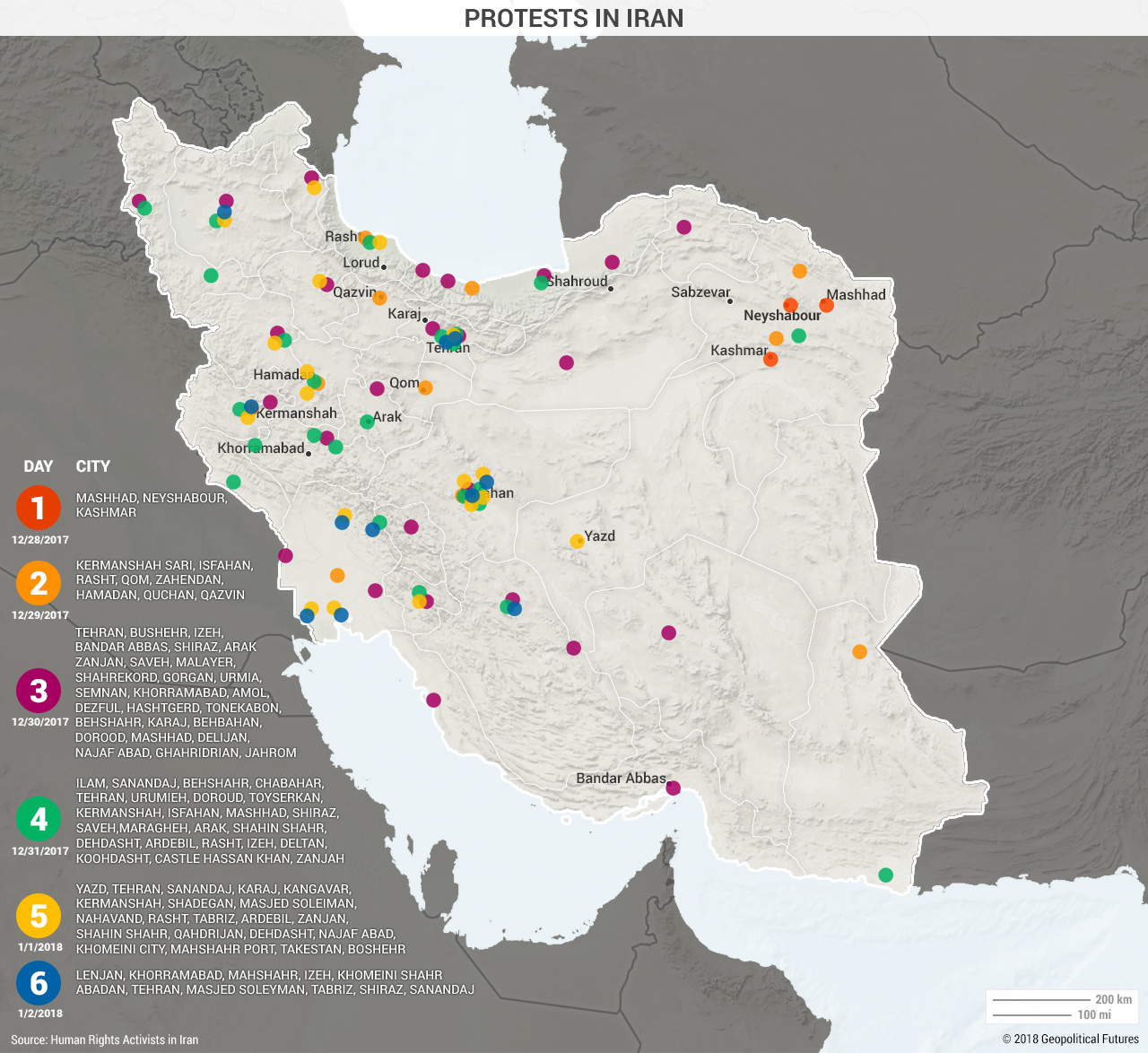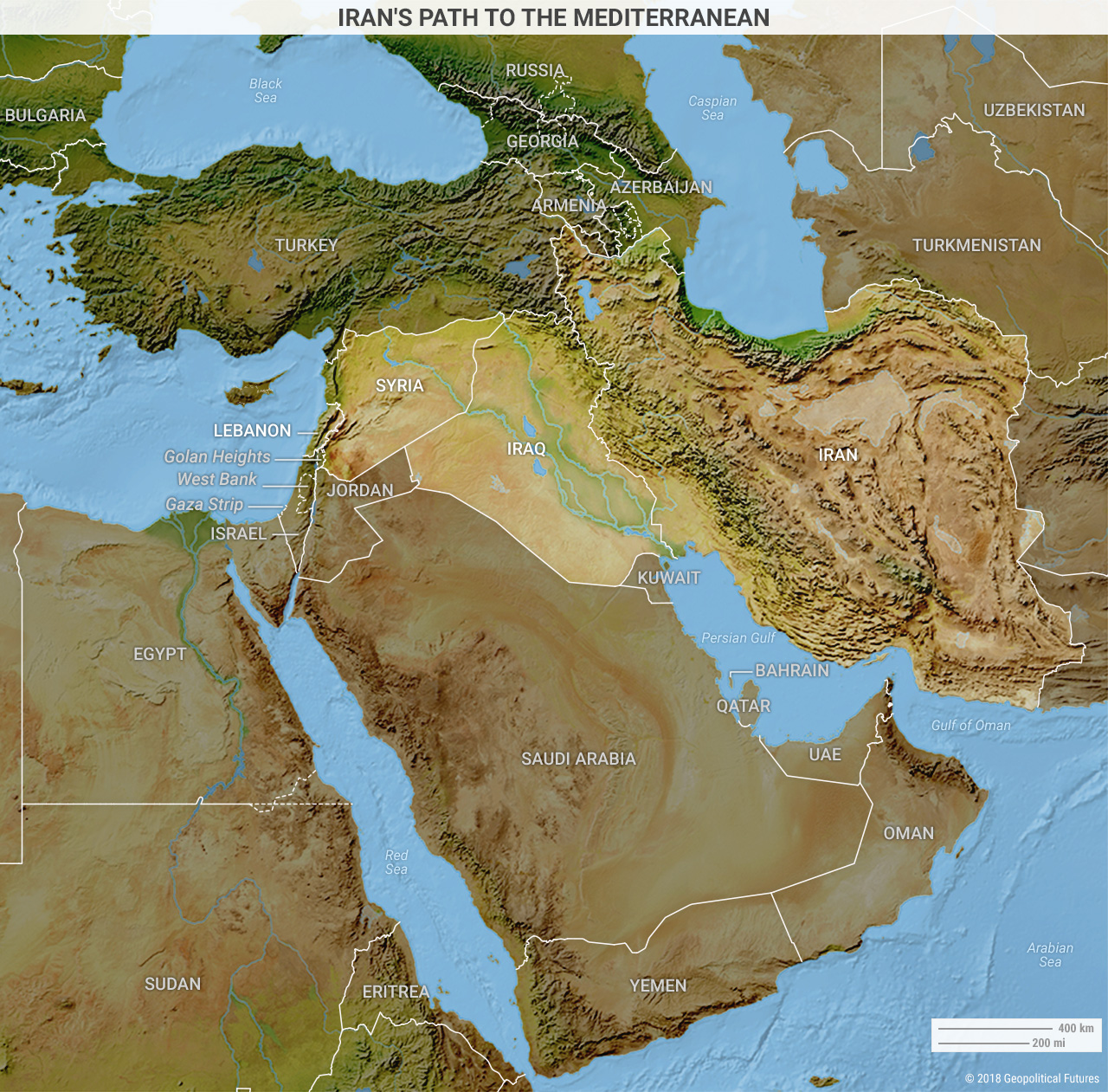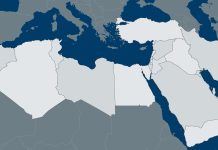By Jacob L. Shapiro
When protests erupted in Iran at the end of December, the cause seemed obvious. The price of basic food staples like eggs and poultry rose by almost 40 percent in a matter of days, and data from Iran’s central bank showed a general rise of the inflation rate throughout the country. And yet, even at the time, there was something inadequate about this explanation. The protesters were everyday civilians, not students or political activists – and they had not risked their lives to protest in 2012 or 2013, when economic conditions were far worse. If the price of a carton of eggs rises temporarily from $3 to $4.20, it is hardly welcome, but it is also not the type of thing that leads to revolution.
After the protests broke out, there were two even more befuddling anomalies. First, the protests were not put down, at least not at first. It took the security forces three days to crack down in earnest. Second, the Iranian government went out of its way to support the right of the protesters to express their discontent. President Hassan Rouhani himself said the Iranian people were free to criticize their government, though he and government news outlets differentiated between what were described as “legitimate grievances” and rioters who were trying to co-opt the protests for their own politically subversive motives.
This line of thinking leads to an irresistible inference – namely, that the protesters who first took to the streets were not afraid of a crackdown. Our initial interpretation of the protests assumed economic conditions had become so bad and domestic frustration so acute that dissatisfaction with the government overrode the protesters’ fear – neither of which seems accurate in hindsight. This leads to another possible interpretation: that the initial protesters did not think they were going to be harmed. They had no fear because they had nothing to fear. Their protests had been unofficially sanctioned for a discrete political purpose, and they knew to go back home before the crackdown began.
Signs Emerge
We should be clear that there is still no direct evidence that a higher power had a role in directing the protests. But since the Islamic Revolutionary Guard Corps announced on Jan. 4 that the initial protests it blamed on Iran’s foreign enemies (America and Israel, among others) had been “defeated,” the anomalies have only multiplied. Those anomalies, culminating in last week’s protests against Iranian women being legally obligated to wear the hijab, all lend credence to the theory that the initial protests in December were in fact politically motivated, and that a much deeper struggle for political power in Iran is raging.
One example of this power struggle was the sudden proliferation of reports last month relating to Ayatollah Ali Akbar Hashemi Rafsanjani, a former multiple-term Iranian president who died in January 2017. Shortly before the protests broke out, Rafsanjani’s daughter told E’Temed News that her father had radiation levels “10 times more than the allowed level” at the time of his death. Soon after the protests were forcibly ended, Rafsanjani’s son said Rouhani had ordered a formal review of the circumstances around Rafsanjani’s death. A few days later, a freelance Iranian Kurdish journalist based in the U.S. released footage of a supposedly secret session in which Ayatollah Ali Khamenei was anointed supreme leader. In the video, Rafsanjani plays a key role in shepherding Khamenei’s confirmation.
The source of the sudden spike in interest around Rafsanjani remains something of a mystery. But what isn’t a mystery is that in the years leading up to his death, Rafsanjani ran afoul of both hard-liners within the Iranian political establishment and the IRGC. Ostensibly, this was because Rafsanjani supported the deal with the United States on curbing Iran’s nuclear program, but the fault lines go much deeper. Rafsanjani represented the views of an Iranian political faction that continues to believe a reduction of state control over the Iranian economy is in Iran’s best interests. That necessarily means curtailing the IRGC’s now wide-ranging powers, as well as reinterpreting some of the basic principles of the revolution, which included state control over most national industries.
Rafsanjani, however, is just a political totem. Far more important is the Rouhani administration’s attempt to realize some of Rafsanjani’s political goals – namely, the privatization of the economy. This is an old story in Iran. The 1979 constitution was reinterpreted in 2006 to allow for privatization of state-owned companies to reduce corruption and increase profits. On the surface, privatization occurred. According to an Iranian parliamentary commission, during President Mahmoud Ahmadinejad’s first term, from 2005-2009, control of more than 300 companies worth more than $70 billion was transferred to the private sector. However, the commission also noted that just 13.5 percent of those companies actually went to the private sector. Much of the rest went to organizations like the IRGC.
As a result, the IRGC is now estimated to control as much as 60 percent of the Iranian economy. This is untenable for the government because it means, in effect, that the IRGC has amassed too much power. Rouhani’s first priority was to close the nuclear deal with the U.S. and open the country back up to foreign capital. But the next and more dangerous priority has been to retake control of the economy from the IRGC. The process began in June 2016, when Khamenei replaced the chairman of the Armed Forces General Staff with an IRGC general. At the time, the move was seen as evidence that the IRGC was asserting even greater control over the affairs of state, but events in recent months indicate the opposite.
Reports began to circulate that the Rouhani administration was engaging in a quiet crackdown on some of the IRGC’s businesses interests. A September 2017 article in the Financial Times, citing an Iranian government official, said that some IRGC members had been arrested and others were being forced to transfer ownership of various holding companies back to the state. In a speech in November, Rouhani stated some of his intentions, noting that he had the support of the supreme leader in this regard, but the target of his remarks was implied, not explicit. (It should be noted that in 2007, Khamenei himself said that following the government’s privatization policies should be seen as a “form of jihad,” indicating his general support.)
Then, on Jan. 21, Iranian Defense Minister Amir Hatami dropped the pretense. In an interview with an Iranian newspaper, he said that the IRGC and the Iranian army would divest themselves of any economic activities irrelevant to their military duties, and that the new chairman of the Armed Forces General Staff would be overseeing this process. The move was not done without some compensation – Khamenei reportedly approved the allocation of $2.5 billion of the country’s National Development Fund for defense spending, perhaps to placate potential IRGC and Iranian army objections to divestment. But the overall trend is clear: The Iranian government is attempting to bring the IRGC and other potentially self-interested fifth columns in the Iranian political system to heel.
So far, the lack of resistance to Rouhani’s moves is striking. If Rouhani and his supporters fail, they may face a fate similar to that of former President Hosni Mubarak in Egypt: out of power and imprisoned. (Mubarak’s son, Gamal, lost the Egyptian military’s support because of his desire to wrest back economic control, which played no small role in the military’s willingness to offer Mubarak as a sacrificial lamb in January 2011 at the height of the so-called Arab Spring.) If they succeed, the government will have centralized a great deal of power, not unlike how Xi Jinping has consolidated government power in China after successfully cracking down on the perks that the People’s Liberation Army enjoyed in recent decades.
Battle Royal
Disagreement among political factions is par for the course in Iran. But this is not just disagreement. This is shaping up to be a battle royal for power, and the stakes are extremely high. The government has a clear view of Iran’s future, one that does not include Iran becoming a de facto military dictatorship. The military may have had to play a large and necessary role in rebuilding the country after the revolution and the subsequent 1980-1988 Iran-Iraq War, but Rouhani, himself a Rafsanjani acolyte, does not think this should be a permanent state of affairs. After making the Iran nuclear deal with the United States, he is now focusing on getting his domestic affairs in order. With the IRGC involved in Iraq, Syria and Lebanon, it is an ideal time for Rouhani to make his move.
How Rouhani’s moves intersect with events over the weekend are worth considering. The hijab protests were not particularly novel or important; they have happened sporadically in the past. The anomaly was that Iran’s Center for Strategic Studies, a think tank that functions as the research arm of the presidency, released a report a few days after police arrested 29 people in connection with the protest. The report, from 2014, states that 49.8 percent of the Iranian public opposed compulsory head covering for women. The release of the study so soon after the hijab protests is either highly coincidental or a clear sign from the Rouhani government that it not only opposes hard-liner views on issues such as these, but that it is also not afraid to make its opposition public.
Perhaps, then, there was more to the December protests than first met the eye. Perhaps elements of the IRGC, dissatisfied with Rouhani’s moves, wanted to demonstrate its indispensability and to remind the administration that it better not get too ambitious in its privatization plans. And perhaps the Rouhani administration sought to take advantage of the situation by turning the focus back on the IRGC, using the momentum from the protests to blame the current system for the lack of economic progress and as justification for more intense reforms. There are a number of “perhapses” in this paragraph, and at this point, this is little more than a theory. It’s a plausible theory, but a theory nonetheless.
In any case, one question in all of this is to what extent, if any, these events will change Iran’s foreign policy. The preliminary answer is not much. Iran continues to press its advantage in the Middle East after the weakening of the Islamic State and the survival of the Assad regime. Via the IRGC, Iran continues to support proxies in Iraq and Syria. Israel has become so concerned with Iran’s moves that it is threatening war against Lebanon for becoming a de facto Iranian missile factory. In addition, Iran is reaching out to Hamas, an old friend it has been on the outs with in recent years, seeking to reclaim some of its influence in the Gaza Strip. None of this has been limited by the domestic unrest in Iran, or in the now accelerating government campaign to curtail the power of the IRGC and similar organizations at home – at least, not yet.









 Special Collection – The Middle East
Special Collection – The Middle East